

 December 22, 1993
December 22, 1993Contained in the report is information for the use of all those interested in the State's finances, including South Carolina taxpayers, members of the General Assembly and directors of the State's executive agencies as well as those investors and creditors with whom the State has an ongoing business relationship.
As the Comptroller General of South Carolina, I present these financial statements as my representations, and I express confidence that the information is accurate in all material respects. The citizens of South Carolina may be further assured that this report contains all material facts about the State's financial condition and thereby reflects my total commitment to accountability to the taxpayers through full public disclosure.
For the convenience of users, we have divided the report into three sections as follows:
Revenues and other sources exceeded expenditures and other uses for the State's General Fund for the first time since 1987-88, a fact as attributable to the State's fiscal restraints as to economic growth. A series of recession- driven appropriation reductions mandated by the Budget and Control Board, on which I serve, in both 1991-92 ($128 million) and 1992-93 ($189 million) paved the way for this operating surplus.
South Carolina's unaccustomed brush with fiscal brinksmanship set off other actions. Pursuant to constitutional and statutory mandate, the State's depleted reserve was increased, and its revenue-projecting methods were modified to produce more conservative estimates, recognizing the likelihood that annual growth in the foreseeable future is likely to be in the 4% to 5% range, rather than the 10% to 11% of earlier years.
A reform-minded legislature carried out the most significant restructuring of State government in almost half a century, consolidating many of the State's agencies into cabinet-like departments under gubernatorial control during fiscal year 1993-94. The State also initiated efficiency-related measures to decentralize some of its administrative authority and to create budget strategies based on performance and outcomes rather than expenditure history alone. I have proposed a statewide performance audit as a means of evaluating and improving the overall effectiveness and efficiency of agency operations in the context of diminishing growth potential for future revenues. Funding priorities for the State became more sharply focused toward health care, public education and corrections. Major legislative initiatives, beyond budget and structural issues, addressed public safety, child protection and welfare reform.
South Carolina government has weathered the economic storm of the last four years, but its financial future is still one of mixed signals. Job losses through the closing of the military installations in Charleston will be severe, and a number of significant contingent liabilities loom on the horizon. The State, however, seems to have taken some major steps to "weatherize" itself, right-sizing and adjusting its operations to cope with leaner times ahead.
The State's tourism and retirement industries have also been rapidly growing economic sectors over the last two decades. Each year more retirees move here to take advantage of the area's mild climate, lower cost of living and special tax breaks for people over 65 years of age. The number of individuals receiving Social Security retirement pay has grown at a rapid average annual rate of 4.5% since 1970. The annual income from retirement now exceeds an estimated $4 billion.
The coastal areas of the State have emerged as one of the leading tourism centers on the east coast, providing even more stimulus to South Carolina's growing economy. Personal income in Horry County, which includes the Myrtle Beach area, has grown at an extraordinary 11.5% per year over the last two decades and now exceeds $2 billion.
Since 1970, nearly 400,000 people have migrated to the State to take advantage of a growing economy and to retire here. Total personal income of South Carolina has grown more than six-fold, one-fourth faster than growth in personal income in the United States. During the high inflationary 1970's personal income grew at an average annual compound rate of 11.0%, compared to a much lower 9.8% nationwide. Even in the lower inflationary 1980's personal income in South Carolina grew a healthy 8.0% per year, compared to a lesser 7.4% nationwide. Employment in South Carolina over the last two decades has grown one-fifth faster than in the United States as a whole.
Although South Carolina has been one of the poorer states in the nation since the War Between The States, the State is closing the gap in wealth between it and the rest of the country. In 1970, per capita income of South Carolina was only 74% of the national average, but has since increased to 81% of the national average.
The State's economy has recovered from the recession and has begun fiscal year 1993-94 on a positive footing. The State's rainy day reserve, which had increased to $66.8 million during 1992-93, further increased to $100.2 million early in 1993-94. Employment in the State was up by over 50,000 in October 1993 versus its level in October 1991 during the recession. Although statistics for the fiscal year 1993-94 were not yet available from the Department of Commerce, the State's Board of Economic Advisors estimated that personal income growth was in the healthy range of 5% to 6%.
Even though the Federal government's Base Closure and Realignment Commission placed the Charleston Naval Base on its list of bases to be scaled back by 1996, the outlook for the near term is for continued growth in the State's total income in the range of 4% to 5% or more. Construction of the new Bavarian Motor Works (BMW) auto assembly plant in Spartanburg County has already begun and will offset some of the losses at the Charleston Naval Base. There have been other announcements of new plants or additions to existing plants in the State which will contribute to the State's continued growth.
The State's Board of Economic Advisors projected that the State's Budgetary General Fund revenues for 1993-94 would increase by 4.6% over 1992-93. Because of the fixed-rate taxes, tax decreases and nonrecurring revenues, however, the Board's official revenue estimate reflected a historically low 3.5% revenue growth rate. At the end of the first two months of 1993-94, Budgetary General Fund revenue collections were ahead of this estimate. Accordingly, it is anticipated that actual revenues for 1993-94 will meet or exceed the estimate. The Income Tax and Sales Tax, the State's two leading sources of revenues, were both healthy, indicating that the State's economy was growing as expected.
An automated system in the Comptroller General's Office designed to allow reporting in accordance with generally accepted accounting principles (GAAP) converts budgetary-basis STARS data into the format presented in this report. State agencies which use STARS complete forms at year-end to adjust the budgetary-basis balances to conform with GAAP. The Comptroller General's Office enters data from these forms as well as from audited financial statements for the higher education institutions and most State enterprise entities into the GAAP reporting system.
The State's internal control structure provides reasonable, but not absolute, assurance that:
Budgetary Controls
South Carolina's annual Appropriation Act includes legally adopted
budgets for the Budgetary General Fund and for aggregated Other Budgeted
Funds. Except for the Retail Sales Tax and selected other taxes, which are
estimated on a modified accrual basis, the State estimates revenues on a cash
receipts basis. Appropriations for 1992-93 covered all expenditures deemed
applicable to that year and paid on or before July 20, 1993. Unexpended
Budgetary General Fund appropriations lapse unless the Appropriation Act
specifically authorizes agencies to carry them forward to the next fiscal year.
State law does not require encumbrance accounting. Accordingly, the State does not record encumbrances (except for some higher education institutions). The State currently maintains budgetary control for expenditures at the level of major object class within each program of each organizational unit. Except for accounts of higher education institutions and the Department of Highways and Public Transportation, STARS checks to be sure that an account has sufficient remaining appropriations before it will charge an expenditure to that account. (As a result of legal changes, the Department of Highways and Public Transportation is no longer an exception effective on July 1, 1993.) Organizational units may request transfers of appropriations among major object classes and/or among programs within the same budgetary fund. The Budget and Control Board has authority to approve these appropriation transfers within certain limits.
The initial budget appears in the annual Appropriation Act. The Budget and Control Board reduces the Budgetary General Fund's appropriations during the year if it anticipates a year-end operating deficit. Likewise, the State Board of Economic Advisors may recommend and the Budget and Control Board may approve revisions of estimated revenues of the Budgetary General Fund during the year, if necessary. Such revisions were necessary during the fiscal year ended June 30, 1993.
During June 1993, the General Assembly enacted a Supplemental Appropriation Act. The Act required that the first $33.8 million of available funds on the budgetary basis of accounting at year-end be reserved (in the General Reserve) and that the next $32.5 million be recorded as supplemental appropriations. The Act further authorized the carry-forward of the supplemental appropriations to 1993-94. Because sufficient funds were available on the budgetary basis, the supplemental appropriations were recorded and carried forward to 1993-94.
State law specifies procedures for processing requested budget changes in Other Budgeted Funds and for permanent improvement projects.
The most important element of oversight authority is financial interdependency. Other elements of oversight authority include selection of governing authority, designation of management, ability to significantly influence operations and accountability for fiscal matters.
This report includes all organizational units of the State that are either controlled by or dependent upon the State's legislature or constitutional officers. Note (1a) in the Notes to the Financial Statements provides a more complete description of the State's reporting entity and the criteria used in defining it.
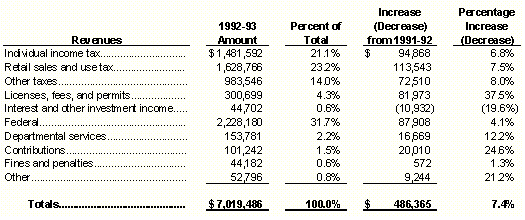
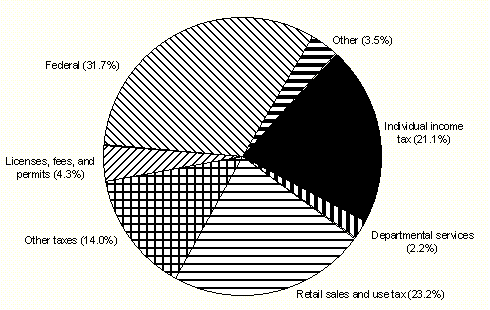
The decrease in Interest and Other Investment Income was a result of the decline of interest rates applied to various deposits and investment balances.
Several changes in revenue resulted from changes in the Medicaid and Medicare programs. Specifically, the increase in Contributions revenue was due to increases in receipts of Medicaid disproportionate share monies and other matching funds. The increase in Other Revenues was due to increased refunds of prior-year Medicaid and other program expenditures. The increase in Departmental Services was primarily due to an increase in the volume of Medicare claims and related reimbursements.
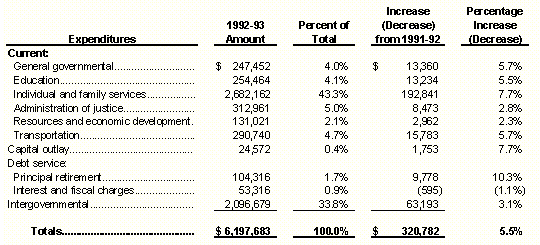
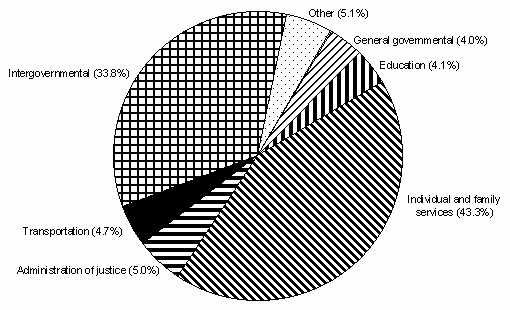
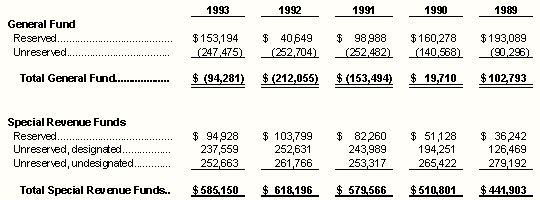
The designated portion of unreserved fund balance reflects tentative plans for future use of available financial resources.
Total fund balance in the General Fund has remained below zero for the past three years. I and other State officials have noted this trend with concern. We are carefully monitoring tax revenue collections for the 1993-94 fiscal year. Whenever revenue collections are determined to be below estimates, estimated revenues and appropriations will be revised downward before year-end. We believe that this, combined with newly enacted reforms in the budgeting process discussed above, will eventually result in a positive fund balance for the General Fund.
There are several other significant proprietary segments of South Carolina's State government. The Ports Authority develops and maintains State harbors and seaports and handles the commerce through these ports. The State Housing Finance and Development Authority provides low-cost housing to the State's citizens by issuing bonds/notes and by administering Federal contracts and grants. The Education Assistance Authority makes loans to eligible students.
The Public Service Authority (Santee-Cooper) and other major Proprietary Funds of South Carolina are presented below with highlights of segment financial information (expressed in thousands) for the fiscal year ended June 30, 1993.


Moody's Investors Service has rated South Carolina's general obligation bonds as "Aaa," representing the highest rating awarded. For many years, Standard & Poor's also applied its top rating ("AAA") to these bonds. From March 1992 through January 1993, however, Standard & Poor's placed the State "on CreditWatch with negative implications." On January 29, 1993, Standard & Poor's lowered the State's rating on general obligation bonds to "AA+." On October 27, 1993, Fitch Investors Service, Inc., announced its first rating of South Carolina's general obligation bonds. Fitch assigned its top rating of "AAA."
Standard & Poor's has stated that South Carolina must improve the structural balance between its revenues and expenditures and must address the GAAP accumulated deficit in the Budgetary General Fund in order to regain its former "AAA" rating. During the fiscal year ended June 30, 1993, the State made progress toward those goals. Specifically, the GAAP accumulated deficit decreased by $118 million (from $212 million at June 30, 1992, to $94 million at June 30, 1993). In addition, the General Assembly enacted legislation to limit appropriations in its Budgetary General Fund beginning in 1994-95. Under the new law, when the General Assembly enacts the annual general appropriations bill, appropriations may not exceed the lesser of:
The State's available legal debt margin at June 30, 1993, was $150 million for highway bonds and $16.8 million for institution bonds. State law limits annual debt service expenditures rather than directly limiting the amount of outstanding debt for general obligation bonds/notes other than highway bonds, institution bonds, tax anticipation notes, and bond anticipation notes (if any). The annual debt service margin at June 30, 1993, for these bonds was $14.4 million.
Net general obligation bonds/notes outstanding per capita (which excludes general obligation bonds payable from Higher Education Funds) is a useful indicator to citizens, investors and management of the State's debt position. The following table shows these amounts at June 30 for the last three years:


Legally authorized investments vary by fund, but generally include obligations of the United States and certain agencies of the United States, obligations of the State of South Carolina and certain of its political subdivisions, certificates of deposit, collateralized repurchase agreements and certain obligations of United States corporations.
As provided by law, the State Treasurer deposits money in a general deposit account. The State records earnings of the general deposit account as revenue of the General Fund. The Treasurer deposits other monies into various special deposit accounts, each of which retains its own earnings.
State agencies which issue their own checks participate in pooled bank accounts. These agencies issue checks against the pooled bank accounts. Meanwhile, the State Treasurer invests account balances until the checks clear.
Investment earnings for the General Fund totaled $38.0 million for the fiscal year ended June 30, 1993.
The State conducts various risk control programs to help minimize losses. For example, the health insurance program conducts extensive wellness education programs for covered employees that promote development and maintenance of healthful lifestyles.
The State also administers the Patients' Compensation Fund, a public entity risk pool reported within the State's Enterprise Funds, which provides medical malpractice insurance.
The audit described above is not intended to meet the requirements of the Federal Single Audit Act of 1984. The Single Audit reports for the State are issued separately.
Again this year, the State will submit its CAFR to the Certificate of Achievement for Excellence in Financial Reporting program of the GFOA. I firmly believe that South Carolina's report for the fiscal year ended June 30, 1993, meets the requirements to receive the Certificate of Achievement.
Special thanks are due to Dr. Rodger E. Stroup of the South Carolina State Museum and to the staff of the South Caroliniana Library for providing historical data and for obtaining photographs for this report. In addition, thanks are due to Dr. William C. Gillespie, Chief Economist of the State of South Carolina, and to Philip G. Grose, Jr., Director of the State Budget and Control Board's Executive Institute, who provided invaluable assistance in producing the report.
Sincerely,
EARLE E. MORRIS, JR.
Comptroller General
State of South Carolina